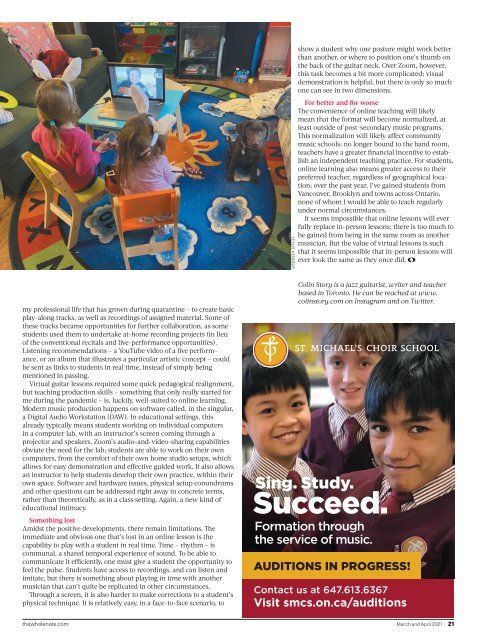Volume 26 Issue 6 - March and April 2021
96 recordings (count’em) reviewed in this issue – the most ever – with 25 new titles added to the DISCoveries Online Listening Room (also a new high). And up front: Women From Space deliver a festival by holograph; Morgan Paige Melbourne’s one-take pianism; New Orleans’ Music Box Village as inspiration for musical playground building; the “from limbo to grey zone” inconsistencies of live arts lockdowns; all this and more here and in print commencing March 19 2021.
96 recordings (count’em) reviewed in this issue – the most ever – with 25 new titles added to the DISCoveries Online Listening Room (also a new high). And up front: Women From Space deliver a festival by holograph; Morgan Paige Melbourne’s one-take pianism; New Orleans’ Music Box Village as inspiration for musical playground building; the “from limbo to grey zone” inconsistencies of live arts lockdowns; all this and more here and in print commencing March 19 2021.
You also want an ePaper? Increase the reach of your titles
YUMPU automatically turns print PDFs into web optimized ePapers that Google loves.
LESLIE KENNEDY<br />
show a student why one posture might work better<br />
than another, or where to position one’s thumb on<br />
the back of the guitar neck. Over Zoom, however,<br />
this task becomes a bit more complicated; visual<br />
demonstration is helpful, but there is only so much<br />
one can see in two dimensions.<br />
For better <strong>and</strong> for worse<br />
The convenience of online teaching will likely<br />
mean that the format will become normalized, at<br />
least outside of post-secondary music programs.<br />
This normalization will likely affect community<br />
music schools; no longer bound to the b<strong>and</strong> room,<br />
teachers have a greater financial incentive to establish<br />
an independent teaching practice. For students,<br />
online learning also means greater access to their<br />
preferred teacher, regardless of geographical location;<br />
over the past year, I’ve gained students from<br />
Vancouver, Brooklyn <strong>and</strong> towns across Ontario,<br />
none of whom I would be able to teach regularly<br />
under normal circumstances.<br />
It seems impossible that online lessons will ever<br />
fully replace in-person lessons; there is too much to<br />
be gained from being in the same room as another<br />
musician. But the value of virtual lessons is such<br />
that it seems impossible that in-person lessons will<br />
ever look the same as they once did.<br />
my professional life that has grown during quarantine – to create basic<br />
play-along tracks, as well as recordings of assigned material. Some of<br />
these tracks became opportunities for further collaboration, as some<br />
students used them to undertake at-home recording projects (in lieu<br />
of the conventional recitals <strong>and</strong> live-performance opportunities).<br />
Listening recommendations – a YouTube video of a live performance,<br />
or an album that illustrates a particular artistic concept – could<br />
be sent as links to students in real time, instead of simply being<br />
mentioned in passing.<br />
Virtual guitar lessons required some quick pedagogical realignment,<br />
but teaching production skills – something that only really started for<br />
me during the p<strong>and</strong>emic – is, luckily, well-suited to online learning.<br />
Modern music production happens on software called, in the singular,<br />
a Digital Audio Workstation (DAW). In educational settings, this<br />
already typically means students working on individual computers<br />
in a computer lab, with an instructor’s screen coming through a<br />
projector <strong>and</strong> speakers. Zoom’s audio-<strong>and</strong>-video-sharing capabilities<br />
obviate the need for the lab; students are able to work on their own<br />
computers, from the comfort of their own home studio setups, which<br />
allows for easy demonstration <strong>and</strong> effective guided work. It also allows<br />
an instructor to help students develop their own practice, within their<br />
own space. Software <strong>and</strong> hardware issues, physical setup conundrums<br />
<strong>and</strong> other questions can be addressed right away in concrete terms,<br />
rather than theoretically, as in a class setting. Again, a new kind of<br />
educational intimacy.<br />
Something lost<br />
Amidst the positive developments, there remain limitations. The<br />
immediate <strong>and</strong> obvious one that’s lost in an online lesson is the<br />
capability to play with a student in real time. Time – rhythm – is<br />
communal, a shared temporal experience of sound. To be able to<br />
communicate it efficiently, one must give a student the opportunity to<br />
feel the pulse. Students have access to recordings, <strong>and</strong> can listen <strong>and</strong><br />
imitate, but there is something about playing in time with another<br />
musician that can’t quite be replicated in other circumstances.<br />
Through a screen, it is also harder to make corrections to a student’s<br />
physical technique. It is relatively easy, in a face-to-face scenario, to<br />
Colin Story is a jazz guitarist, writer <strong>and</strong> teacher<br />
based in Toronto. He can be reached at www.<br />
colinstory.com on Instagram <strong>and</strong> on Twitter.<br />
ST. MICHAEL’S CHOIR SCHOOL<br />
Sing. Study.<br />
Succeed.<br />
Formation through<br />
the service of music.<br />
AUDITIONS IN PROGRESS!<br />
Contact us at 647.613.6367<br />
Visit smcs.on.ca/auditions<br />
thewholenote.com <strong>March</strong> <strong>and</strong> <strong>April</strong> <strong>2021</strong> | 21


















